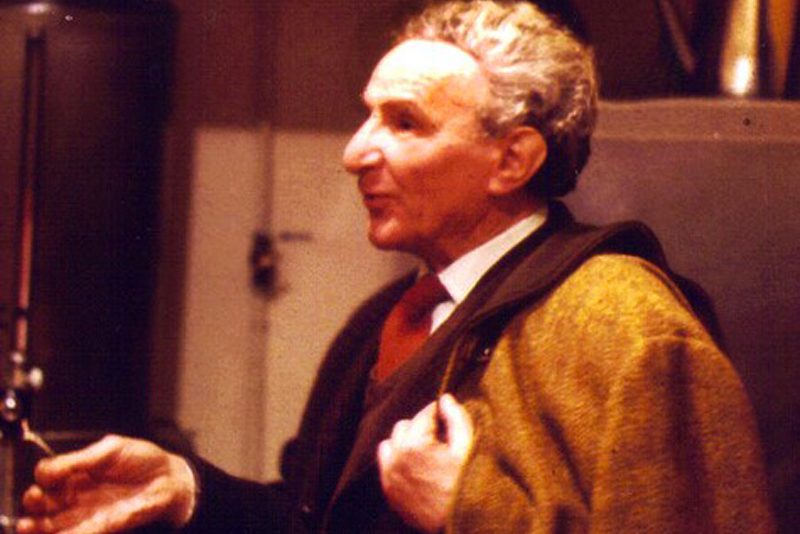
14th April 2022 In Alumni Stories, Emerson Stories By Ellie
Memories of Francis Edmunds and his creation
By Annie Blampied – Radojcin
(Student at Emerson College in the 1980’s)
My first experience of Emerson College was wandering through the grounds waiting for an interview. To the south of the flowering gardens, magnificent specimen trees and formal pond with creamy golden water lilies and the rhythmical sound of water flowing through sculpted forms, I discovered a field. This field was planted with beautifully staked beans and peas, rows of carrots, onions, leeks, and curling stems of courgettes and pumpkin. What I had never seen before were all the flowers and herbs planted alongside and among the vegetables. The air hummed with bees buzzing, and different coloured butterflies flitting about. To one side, in a roughly hewn palisade there grunted the most enormous and contented pig. On the other side grew three ancient strong guardian oak trees. Below I could see the roof tops of houses nestled in the village of Forest Row. It felt like paradise. As I walked back to the buildings I passed tethered goats grazing in a small woodland, bells tinkling round their necks. I later found out all of this was part of the rural development programme and students had come from many (so called) developing countries to learn about applying biodynamic agriculture in small scale farming rural communities.
As a student myself at Emerson College, from 1983 to 86, the founder Francis Edmunds, had come out of retirement to be the principal once again, because the newly appointed principal, John Davy, former Science correspondent for the Observer newspaper, had suddenly died.
What I learnt most from Francis Edmunds was how to listen. Every week at the College, there would be a “house meeting”. All the students and teachers would gather in Ruskin Hall, together with all the other people who worked there. The cooks would come, still drying their hands from their kitchen work, the gardeners bearing trails of dusty soil, the librarian, all the office staff, even Reception was closed for that precious afternoon hour of meeting. Francis had a special upright wooden chair, with a leather seat and carved arms. He always sat in the front row, his wife, Elizabeth next to him. Wearing an old tweed jacket, Francis would rest his leather patched elbows on the arms of the chair, his finger tips pressed together, his head slightly cocked on one side, his bright brown eyes focused on whoever was speaking. It might have been a learned guest teacher, or a stammering student speaking in public for the first time, a musician or choir performing, someone speaking about current affairs, someone telling us news from the kitchen, another announcing events to look forward to that weekend, a group of students performing a skit to get some point across about community living. Whatever is was, Francis would give his full attention. He had very large and well formed ears, that seemed to magnifiy his listening, but really it was his heart that was listening. His example of deep respect and being present with someone in that moment is a liefmotif of Emerson College that still rings true today.
Francis travelled far and wide, across the oceans to canvas for Emerson College. He wanted it to be a place that served the whole world.
In the Autumn term, as soon as the students had caught their breath, settling into their different course, the International Evening would be announced. This was an opportunity for students from the same country to find each other, and rehearse something that would reflect the soul mood of their country. It could be a song, a skit, a story, a poem, a dance. It could be deeply serious or totally hilarious. With over thirty different nations represented, and always a group of talented second or third year students making the links between sketches, and holding it all together with their own running comedic show, it was an unforgettable evening, giving the most wonderful feeling and insight into the soul mood of each nation. I will always remember a small group of Irish, walking round in a circle, one dressed as a priest, hitting his head with the Bible, doing penance, or a group of powerful Icelandic women making us quake with their feminine power, or the rows of Japanese dancers dressed in orange, black and white, filing the stage, moving in rhythmic formations, to the beat of one huge drum, or the solo Turkish man dancing with a harem of veiled women.
Some times classes would be cancelled and we would all go down to Tablehurst, a biodynamic farm, which was next door, and at that time owned by College. We would help with harvesting the leeks and potatoes, for example, and be returned to the College, in the late afternoon, piled on to a tractor trailer, exhausted and happily singing. We were also expected to help once a week in the garden with any jobs that needed doing as well as help with house duties like vacuuming, polishing and early morning veg prep. The number of students was so large, that many of us had to live in the village, in rooms in local people’s houses. Students would get local jobs to help make ends meet, and some would fall in love or stay for further work, for example at the local Michael Hall Steiner school. Thus, over the years, the village population was enriched by those who settled here from many different parts of the world.

